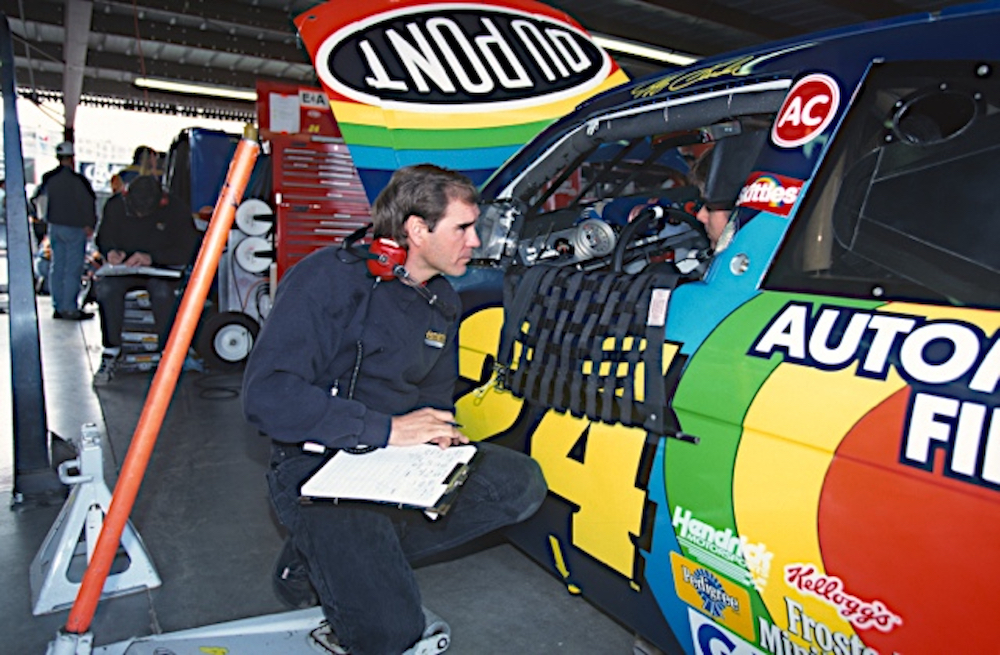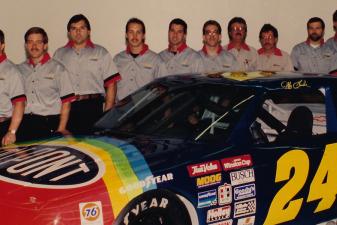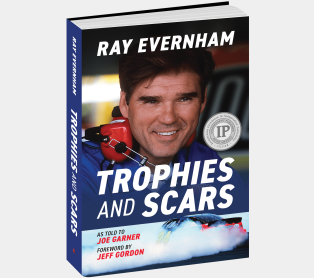"Ray, I'm Jeff Gordon"

The following is an excerpt from NASCAR crew chief Ray Evernham's autobiography, Trophies and Scars. You needn’t be a racing fan to appreciate Evernham’s inspiring journey of tireless persistence, radical determination, steadfast leadership, and fearless reinvention. For as he believes, a life lived to the fullest is packed with trophies—and scars. In this excerpt, read about the meeting between Jeff Gordon and Ray Evernham that started it all.
I got a call from my friend Andy Petree in September 1990—a time when I was still focused on my race driving career. Andy was the crew chief for the No. 33 Winston Cup car driven by Harry Gant and owned by Leo Jackson. He explained that Jackson’s son-in-law, Hugh Connerty, had just hired a kid to drive for him in the last few races of the NASCAR Busch Grand National season and wondered if I’d consider becoming the crew chief for the team.
“Who’s the kid?” I asked.
“His name’s Jeff Gordon,” Andy replied, “heard of him?”
Hell yes, I’d heard of him. The first time I heard Jeff’s name was when I learned he drove in sprint car races at just thirteen years old. And of course, I’d watched him compete in the races on ESPN’s Thursday Night Thunder. He was fast as hell, and he was beating the veterans. It didn’t matter what he was driving. He jumped in several different cars and was fast in all of them. He was seventeen or eighteen by that time, but he looked twelve.
At that time USAC was made up of these midget and sprint car guys whose history could be traced back to the old days in Indy. And here comes Jeff, just some kid with long hair, whacking these guys week after week on national television.
I told Andy I’d take the job, and I headed for Charlotte, North Carolina.
I arranged to meet Jeff at a local hotel. He and his mother, Carol, had just arrived from their home in Pittsboro, Indiana. Carol had to accompany Jeff because he was too young to rent a car.
That was always a memorable aspect of our first meeting. I’d come from working with seasoned drivers like Andretti, Foyt, and Unser at IROC, and now I was about to go to work for this kid who’s not old enough to get to the meeting by himself because he can’t rent a car. When I watched them walk into the lobby, I was instantly struck by how small Jeff was. Despite his size, he seemed poised and confident.
He introduced himself with a firm handshake, “Ray, I’m Jeff Gordon. This is my mom, Carol.”
I used to carry a carbon fiber briefcase, because everyone seemed to have one in those days. I noticed Jeff had one, too. As we sat for our meeting, we both opened our briefcases to get a pad and paper. My briefcase had my notepads and books and my notes for Charlotte Motor Speedway, things like that. In Jeff’s briefcase? He had a Nintendo Game Boy, some gum, a stock car magazine, and peanuts. It was kind of funny.

We hit it off immediately. We talked about open-wheel racing and drivers we were fans of. I learned we both shared a love of Indy car racing. You want to work with people who are really excited to do things, and Jeff was.
The next day, we rolled Hugh Connerty’s No. 67 Outback Steakhouse Pontiac onto the speedway at Charlotte. There were several other Busch Grand National competitors running the track, including Davey Allison and Chuck Bown, who claimed the series championship that year. Because Jeff was inexperienced, untested, and potentially risky, it took some maneuvering to secure him a practice spot. This would be his first time driving a stock car since attending Buck Baker’s driving school.
He was doing pretty well but needed some advice on negotiating Turn Three. So, I went over to Chuck Bown and said, “Jeff’s having some issues in Turn Three. Can you help him out and get in the car and make some laps?” Chuck agreed to lend a hand. He took the car out and drove three- or four-tenths of a second faster than Jeff. It was an eye-opener for Jeff. He didn’t know the car was capable of going that fast.
Chuck pulled into the pit and said, “Nope, y’all, the car’s really good.” In true Gordon fashion, Jeff got in and drove it three- or four-tenths of a second faster than Chuck did. As soon as he knew the car could go that fast and he could push it that hard, Jeff unleashed it.
Throughout the day, he kept getting faster, and by the end of practice, he was second only to Davey Allison in lap times. Not only was his speed impressive, but Jeff’s ability to analyze and explain what was happening with the car and the track struck me. He conveyed the situation to me with such clarity and precision that it became easy to understand what adjustments were needed.

The last time I experienced that kind of driver-mechanic dynamic was at IROC. There’s something special those guys have when it comes to communicating with you. It’s like a sixth sense. And that first day I worked with Jeff, I realized he could communicate at that level. When somebody is that young, it’s not based on experience. It’s just natural ability and instinct. I knew he was a special kid right then—he was living up to his reputation.
I could tell that Jeff valued my feedback just as much as I valued his. Even though he didn’t have any real knowledge about driving stock cars, I was able to understand and interpret what he was trying to tell me. Later on, I discovered that our dynamic was similar to how Jeff collaborated with his stepdad, John Bickford. It turns out, John and I are similar in many ways.
John wasn’t there for our meeting—he’d stayed behind in Indiana to work on Jeff’s sprint car for an upcoming race. John later told me Jeff called him that night after the practice and said, “You’re not going to believe this guy. He never stops working on the car, ever.” He told John how organized he thought I was, and that I wrote everything down. “He’s just like you!”
John jokingly replied, “Well, I’m sorry to hear that.” We’ve laughed about that ever since.





